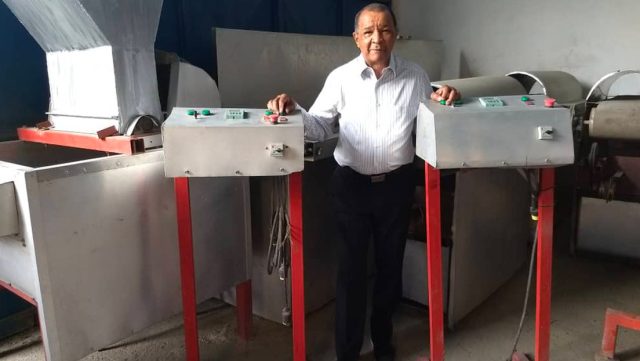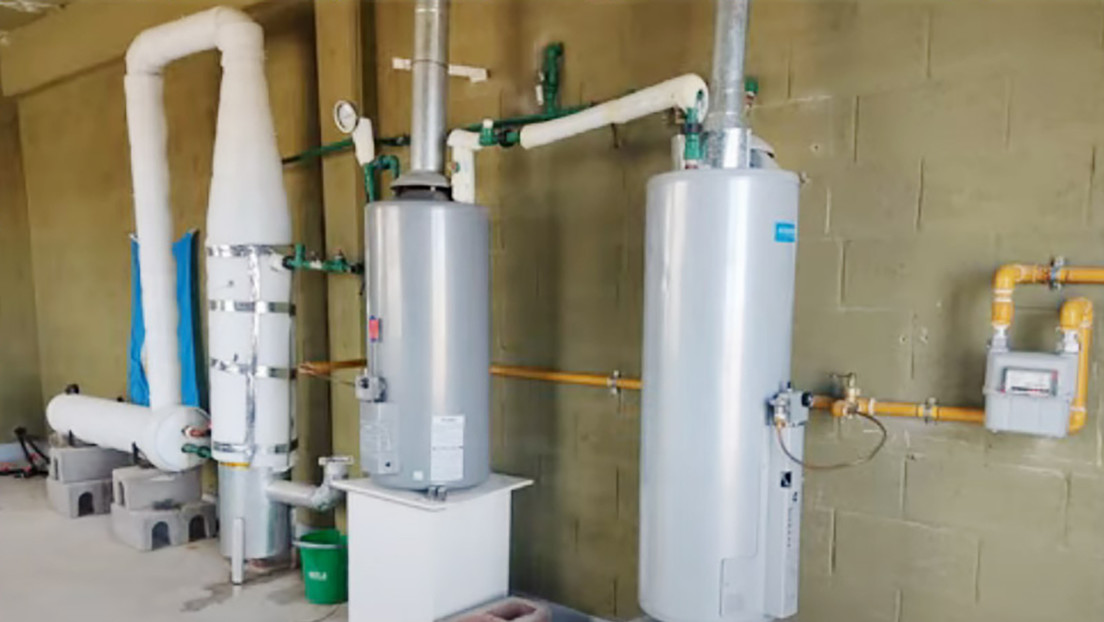Esteban Reales, an engineer who for years worked for the Venezuelan oil industry, has created a multifunctional machine that takes advantage of all the properties and polluting waste of bitter yucca, a poisonous tuber that can only be consumed after a thorough treatment that eliminates the cyanide load that it contains, and that is used in Latin America for the elaboration of flour for cassava, an ancestral food of pre-Hispanic origin.
The machine of this technologist born in Valledupar, Colombia, (1949) and nationalized Venezuelan, manages to put a positive use to the ‘yare’, the poisonous and polluting liquid that the bitter yucca generates during the pressing process to produce the flour.
In an interview with RT, Reales says that his invention started as an exclusive machinery (plant) to produce cassava flour for cassava, after observing the difficult conditions in which artisanal producers make it, in their own customs.
«I was worried because they made the casabe in a very precarious and unhygienic way. They washed the yucca roots in buckets filled with water and dirt, sometimes they cut themselves with machetes, and they wiped their sweat with dirty hands. In the ovens, people faced more than 90 degrees for hours and many of their faces became paralyzed from the heat they received. That’s why I started designing, to make their work more humane, healthy and risk-free», he explained.
Reales —who has his work shed in the city of Guacara, Carabobo state, in the central zone of Venezuela— began to think how he could solve these difficulties, with engineering, and in 2005 he designed a model of the plant with which he won the National Award for Popular Invention «Luis Zambrano», awarded by the Ministry of Science and Technology of Venezuela.
That was just the beginning of a long road. In the following years, with the financing of the Venezuelan State, he managed to correct several prototypes with the suggestions made by the producers and with «a lot of research» on food processing, which served him for the reengineering works.
How does the plant work?
The plant, which can produce 750 kilos of cassava flour every eight hours or one work shift, works with a minimum of 12 workers installed in various stages. In the first stage, two people introduce the tuber into the machine so that it is washed, peeled and passed through ultraviolet rays that eliminate bacteria from the tuber.
When completing this process, the cassava leaves through a special band that transports it to another section where the pieces are grated and taken to a hopper that compresses the product. This part is essential – says Reales – because it separates the flour from the yare, a liquid that is stored in an adjoining area to make other products.
«When the flour comes out of the hopper it’s like a piece of hard cheese», he says. This pressed cassava extract is grated again and falls into a vibrating sieve that separates the smallest grams into a tray, while the rest returns to grating until all the input is obtained.
After these stages, which are monitored through digital monitors by one or two supervisors, the flour falls on the trays and is distributed to the four cooking units that the plant has.
«Two people work in each unit, that is, there are eight cooks who are in charge of the baking process», explains Reales. In this phase, the flour reaches 50 by 50 centimeter square ‘budares‘ (griddle), created with a special alloy of steel called 304, certified for food production.
«We decided that they would be square and not round, like the traditional ones, because a lot of the finished product was lost. Later, a Kariña indigenous woman warned us that the ‘budares’ had to be made of steel because another type of metal, such as aluminum, for example, is very harmful to health, and we obtained the alloy in the industrial zone of Barquisimeto, in the state of Lara».

The «magical» detail achieved by Reales
When the cassava flour is put into gas ovens —although the plant can adapt to other types of energy—, explains Reales, the cooks have the possibility of controlling the cooking through digital devices that measure the temperature and speed for the toasting of the cassava.
«In the ovens is where the magical process of the plant is. Cooks are no longer going to face the 90-degree heat generated by cooking casabe, since each unit has insulation that reduces the temperature perceived by the ‘casabero’. This is one of the great advantages that the plant has in terms of occupational health», he comments.
Reales says that although this process industrializes and changes the artisanal and traditional way of making cassava, the advantages for its producers are many. “They are going to improve their working conditions, reduce physical wear and tear, reduce accidents and injuries, guarantee hygiene and exponentially increase their production”.
“In addition, they will have the possibility of taking advantage of all the resources of the bitter cassava, including the parts that are not taken into account now, such as the stem of the tree and the yare, which when it is thrown away contaminates and poisons the land, leaving it infertile”.
What else can be produced?
Reales, who has been a jury member, several times, for the National Science and Technology Awards in Venezuela, was also concerned that during the production of the flour, only 33% of the tuber was used for each kilo processed.
«Of each kilo of bitter yucca, only 33% can be converted into flour for cassava, 4% is shell and 63% becomes yare«, he says. For the flour, this tuber is used, since sweet cassava has less starch, is more expensive and is harvested in less quantity for each square meter planted.
“Studying bitter cassava, I realized that 100% of what it generates can be used. For example, sour and sweet starches can be produced from yare for the pharmaceutical and food industries. It can also be converted into liquor, through fermentation processes. There are even people who have already shown that with yare, which is a kind of milk, a fuel such as ethanol can be generated».
Reales highlights that the productive experiences with yare are diverse, one of them comes from the Kariña indigenous people who produce liquors from fermented yucca. In fact – he adds – in Colombia and Bolivia they export the liquid to Central America, while in Venezuela it is discarded.
“We can also take advantage of the part of the shell and mix it with the upper part of the stem of the cassava tree to produce animal feed, adding other inputs. Thus, producers would have more income with resources that are now being lost.
Reales waits for the commercialization phase
Reales maintains that after almost two decades of work, he is ready to start the commercialization stage, while he waits for some documents that he processed before the Autonomous Service of Intellectual Property (SAPI).
«We technologists carry out three stages of innovation in Venezuela: the presentation of projects, development and commercialization. But the first two stages take 98% of the financing from the State, so when it comes to marketing, we should ensure that our creations are sold to the institutions that need it, so that they do not have to go looking for it in other countries».
Reales explains that the casabera has a value of 84,500 dollars and needs an extension of 560 square meters for its installation, which would take approximately three months. However, if the producer decided to add the other two processors, it would be extended to about six more months.
Although the secondary sections of the plant are designed to complement the casabera, they also work on their own. In the case of the plant to process the yare, with a value of 31,500 dollars, it needs 210 square meters of extension; while that of animal feed, which is valued at 15,750 dollars, requires 150 square meters for its installation.
If a businessman wanted to acquire the complete system and take advantage of all the production capacity, he would have to invest 131,750 dollars —recoverable in three years— plus six months for the installation, which does not include civil works, and have a space of at least one kilometer square to operate.

The «Realestatic»
Another of the inventions of this Venezuelan is the «Realestatic», a device that eliminates static current for the oil industry, which has a self-diagnosis system that manages to detect failures in the process of filling fuel tanks in refineries.
«The equipment has an electronic card that prevents accidents, because in addition to eliminating the static charge, it automatically stops the filling process when a fault occurs and immediately indicates what needs to be repaired, thus reducing the loss of working hours».
Reales devised it after observing an accident at a filling plant when he worked in the oil industry. That time, a truck entered with static and caused a fire that ended with the explosion of several tanks and the paralysis of the refinery.
With this invention – he comments – the oil industry would not have to import equipment to eliminate static, since Realestatic can be produced 100% in Venezuela.
“It is industrial sovereignty. In fact, when I was looking for the material to make the explosion-proof boxes, I realized that a foreign company had them made here in Venezuela, in Barquisimeto, and they took them away, put their ‘Made in USA’ brand on them and then, they wanted to sell them to us».
These devices have a value of 5,000 dollars and he has managed to place them in certain places in Venezuela and Colombia. In addition – he says – they are easy to manufacture and he has several ready for sale.



